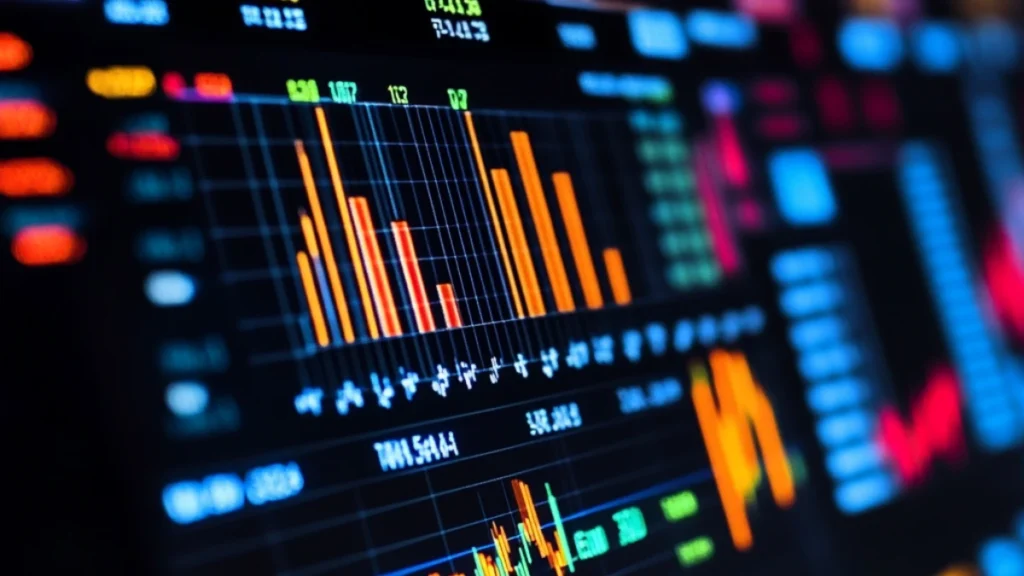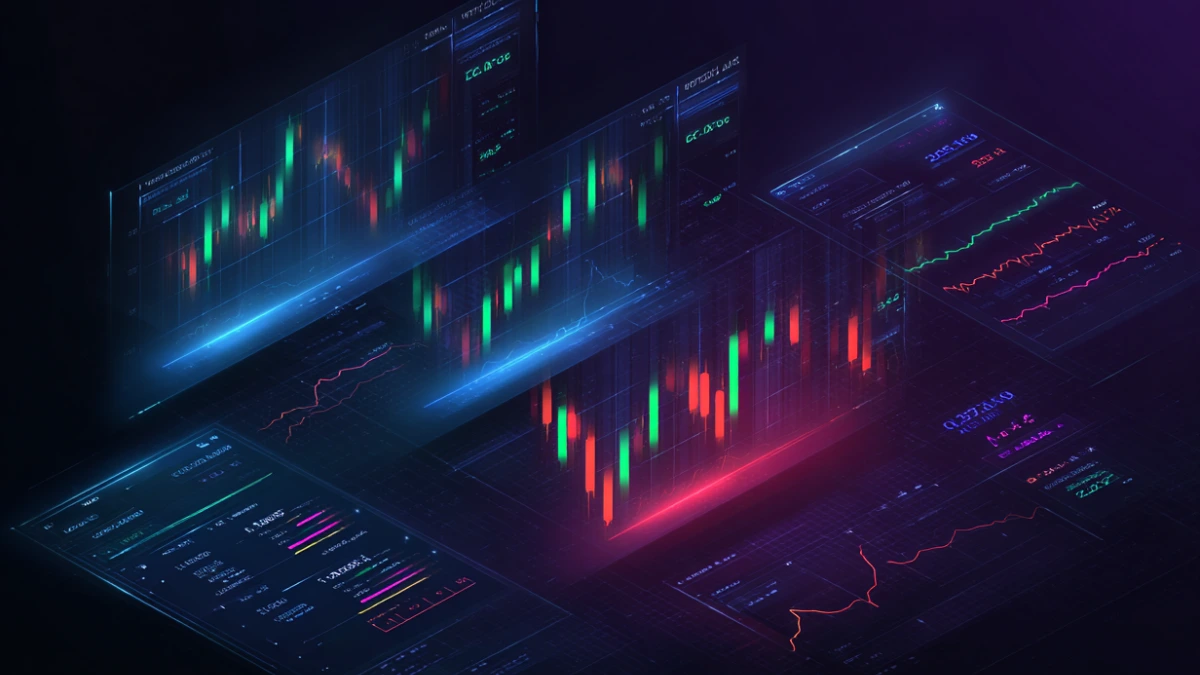Table of Contents
Introduction
Most beginner traders obsess over candlesticks, indicators, and patterns — but never learn to read the real activity behind price movement.
Order flow trading gives you direct insight into who is buying, who is selling, and how aggressive they are in real time.
Instead of relying solely on lagging indicators, order flow tools let you track market participants — including institutions — as they act. It’s like switching from watching a replay to seeing the game live.
In this beginner’s guide, you’ll learn:
• What order flow is and how it works
• The key tools used to read order flow (DOM, Footprint, Delta, etc.)
• How order flow can improve your entries and exits
• Why reading the tape separates average traders from professionals
Whether you’re trading futures, forex, or crypto — understanding order flow can transform how you see the market.
🧾 What Is Order Flow in Simple Terms?
Order flow is the real-time record of buy and sell orders entering the market. It shows you how many contracts or lots are being traded, whether they’re aggressive market orders or passive limit orders, and at what price they’re being filled.
Think of it like this:
• A candlestick tells you what happened during a time period.
• Order flow tells you how it happened, who pushed the move, and where buyers or sellers got absorbed.
There are two main players in order flow:
• Aggressive buyers/sellers who use market orders to get filled immediately
• Passive buyers/sellers who place limit orders and wait to get filled at their price
When you see a sudden burst of aggressive buying into a wall of sell orders — that’s meaningful. It tells you about intention, strength, and imbalance, not just price direction.
Order flow lets you go beyond price and into the psychology of the market — where professionals leave their footprints.

📊 Core Tools of Order Flow: What Beginners Should Know First
Order flow trading sounds advanced — but you only need to master a few key tools to start seeing results:
- DOM (Depth of Market)
Also called the ladder, the DOM shows you live bid and ask orders at each price level.
• You can see where large orders are waiting (liquidity zones)
• You can track how fast prices move between levels (momentum)
• You can spot spoofing or absorption (when large orders don’t get filled)
- Footprint Charts
A footprint chart breaks down each candle into a detailed view of:
• Buy vs sell volume at each price level
• Imbalances between aggressive buyers and sellers
• Absorption zones where one side keeps absorbing the other
This gives you insight into who’s in control — not just where price is moving.
- Delta
Delta = Buy Volume – Sell Volume
It shows the net aggressive buying or selling in real time.
• Positive delta → buyers are hitting the ask
• Negative delta → sellers are hitting the bid
Tracking delta helps you see momentum shifts before price turns.
- Cumulative Delta
Instead of just looking at one candle, cumulative delta shows the overall pressure building up across a session.
• Rising price + falling delta = divergence (possible trap)
• Falling price + rising delta = hidden buying (potential reversal)
These tools may seem complex at first — but even just watching one of them consistently will train your eye to spot strength, weakness, traps, and shifts in control.
🧠 How Order Flow Helps You Time Entries Like a Pro
Most beginner traders enter based on candlestick patterns, moving averages, or RSI — but those tools lag. By the time you get confirmation, the smart money has already entered.
Order flow changes that.
It lets you see the shift in control between buyers and sellers as it’s happening, not after the fact.
Here’s how it helps:
✅ Spot Real Breakouts (Not Fakeouts)
With order flow, you can confirm if a breakout is driven by strong buying/selling pressure — or just a weak push with no volume.
This protects you from chasing false moves.
✅ Time Reversals with Precision
You can see aggressive buyers getting absorbed into a wall of sell orders. That’s a red flag — and often the start of a reversal.
Order flow reveals this before price even flips.
✅ Ride the Momentum
When delta spikes and cumulative delta accelerates, it means buyers or sellers are fully in control. That’s your green light to enter with confidence and let the move run.
✅ Exit Before It’s Too Late
You’ll often see a sudden shift — buyers slow down, sellers push in, or absorption begins. That’s your cue to lock in profits or cut losses before the turn.
Bottom line: Order flow gives you clarity, confidence, and timing — all critical for consistent trades.
🎯 Order Flow for Beginners: 3 Simple Use Cases
If you’re new to order flow, don’t worry — you don’t need to master every tool at once. Here are three practical ways to start using it right away:
- Confirming Breakouts
You’re watching a key support or resistance level. Instead of entering blindly:
• Wait for a breakout
• Watch the Footprint chart or Delta
• If you see aggressive volume + follow-through, it’s likely real
🔁 If the breakout happens with weak delta or quick absorption, skip the trade — or prepare for a reversal.
- Catching Reversals with Absorption
Price spikes into a major level (like a supply/demand zone). You’re unsure if it’ll break or reverse.
Look for:
• Repeated aggressive buying with no price movement
• Large passive sell orders holding the line
• Divergence between price and cumulative delta
These are signs of absorption — meaning the move is likely done.
- Entering with Momentum
Once you’ve confirmed the trend direction, use delta to:
• Spot rising pressure (e.g., positive delta increasing = buyers in control)
• Time your entry as the volume builds
• Ride the move while order flow supports your trade
🧠 Pro Tip: Don’t overcomplicate it. Just ask:
“Are buyers or sellers in control right now?”
Then trade in that direction — with a clear stop.
🧪 Order Flow vs Traditional Indicators: Why It’s a Game Changer
If you’ve used RSI, MACD, Bollinger Bands, or moving averages before, you’ve probably felt a step behind. That’s because these tools are based on historical price, not current market pressure.
Let’s compare:
Tool What It Shows Lag or Live? Best For
RSI Overbought/Oversold conditions Lagging Spotting extremes (late)
MACD Momentum crossover Lagging Confirming trends
Moving Averages Trend direction Lagging Smoothing price noise
Order Flow (Delta, DOM, Footprint) Real-time buyer/seller pressure Live Timing entries and exits with precision
🔍 Why This Matters for Beginners:
• Indicators show what has happened.
Order flow shows what’s happening right now.
• Indicators can give false signals.
Order flow lets you spot traps and fakes before you enter.
• Indicators delay your entry.
Order flow gives you the confidence to act on live data — just like pros do.
If you’re tired of being late to trades, second-guessing your entries, or falling for fake breakouts, learning basic order flow will transform how you approach the market.

📌 Final Thoughts: Why Order Flow Is the Ultimate Confidence Booster for New Traders
Order flow isn’t just for advanced traders — it’s a game changer for beginners who want to stop guessing and start trading with confidence.
Instead of relying on lagging indicators, outdated signals, or gut feelings, you’ll be able to:
• See who’s in control — buyers or sellers — in real time
• Avoid traps and fakeouts that ruin most beginner accounts
• Enter and exit with precision, not emotion
• Grow faster by understanding what’s happening behind the candles
You don’t need to master every tool at once. Start small: learn delta, watch the DOM, and track cumulative volume. The more you observe order flow, the more you’ll think like a pro — and that’s what leads to consistency.
Before wrapping up, it’s important to realize that mastering how market participants behave in real time is one of the most transformative shifts a trader can make. Instead of relying on signals that reflect what has already happened, learning to read live transactional behavior allows you to understand why something is happening — and that’s what gives you a professional edge. This approach takes some time to get used to, especially if you’ve been conditioned to follow typical chart patterns or lagging tools, but the payoff is substantial.
You’ll begin to see things others miss: moments where large traders absorb volume, subtle signs of exhaustion before a reversal, or a momentum spike that confirms you’re on the right side of a breakout.
These are clues that appear as events unfold, not after the fact — and when you know how to interpret them, your confidence grows because you’re reacting to real information, not just guesses or patterns. If you’re looking to build a more well-rounded foundation, pairing these techniques with solid technical tools is a great next step. We recommend reading our full beginner’s guide to moving averages in trading — it breaks down how to combine EMAs and SMAs with price context for stronger decision-making. For those ready to dive even deeper into institutional-style methods, EdgeClear’s primer on reading the tape offers an excellent breakdown of how volume, liquidity, and trade intent all come together to shape price.
Remember: consistent profitability doesn’t come from memorizing setups — it comes from understanding what’s happening beneath the surface of every move you take. The more you train your eyes to follow real-time behavior, the more your instincts will shift from reactive to predictive — and that’s the mindset elite traders live by.
🔑 Bottom line: If you’re serious about becoming a profitable trader in 2025 and beyond, learning order flow will give you the edge most beginners never discover.

